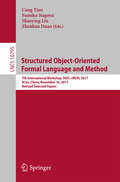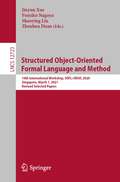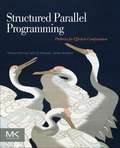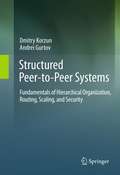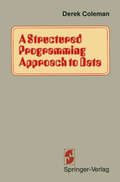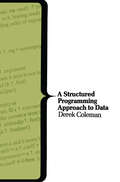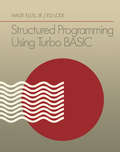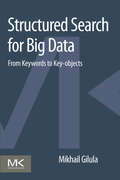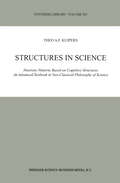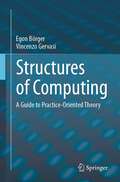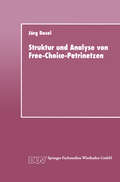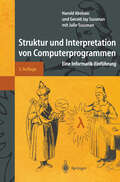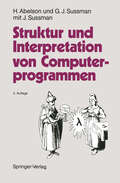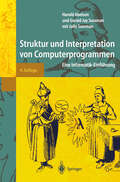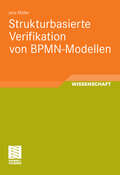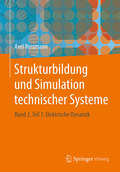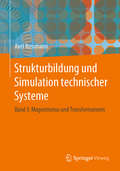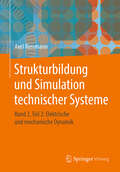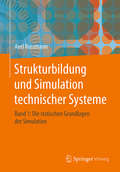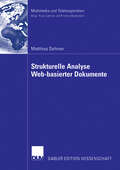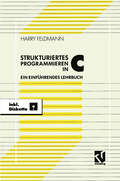- Table View
- List View
Structured Object-Oriented Formal Language and Method: 7th International Workshop, SOFL+MSVL 2017, Xi'an, China, November 16, 2017, Revised Selected Papers (Lecture Notes in Computer Science #10795)
by Cong Tian Fumiko Nagoya Shaoying Liu Zhenhua DuanThis book constitutes the thoroughly refereed workshop proceedings of the 7th International Workshop on Structured Object-Oriented Formal Language and Method, SOFL+MSVL 2017, held in Xi’an, China, in November 2017. The 13 revised full papers included in the volume were carefully reviewed and selected from 21 submissions. They are organized in the following topical sections: animation and prototyping; graph theory; model checking; modeling and specification; and verification and validation.
Structured Object-Oriented Formal Language and Method: 10th International Workshop, SOFL+MSVL 2020, Singapore, March 1, 2021, Revised Selected Papers (Lecture Notes in Computer Science #12723)
by Jinyun Xue Fumiko Nagoya Shaoying Liu Zhenhua DuanThis book constitutes the refereed workshop proceedings of the 10th International Workshop on Structured Object-Oriented Formal Language and Method, SOFL+MSVL 2020, held in Singapore, in March 2021. The 13 revised full papers included in the volume were carefully reviewed and selected from 24 submissions. They are organized in the following topical sections: modeling and specification; model checking; specification and verification; and testing and formal verification.Due to the Corona pandemic this event was held virtually.
Structured Parallel Programming: Patterns for Efficient Computation
by James Reinders Michael McCool Arch RobisonStructured Parallel Programming offers the simplest way for developers to learn patterns for high-performance parallel programming. Written by parallel computing experts and industry insiders Michael McCool, Arch Robison, and James Reinders, this book explains how to design and implement maintainable and efficient parallel algorithms using a composable, structured, scalable, and machine-independent approach to parallel computing. It presents both theory and practice, and provides detailed concrete examples using multiple programming models. The examples in this book are presented using two of the most popular and cutting edge programming models for parallel programming: Threading Building Blocks, and Cilk Plus. These architecture-independent models enable easy integration into existing applications, preserve investments in existing code, and speed the development of parallel applications. Examples from realistic contexts illustrate patterns and themes in parallel algorithm design that are widely applicable regardless of implementation technology. Software developers, computer programmers, and software architects will find this book extremely helpful.The patterns-based approach offers structure and insight that developers can apply to a variety of parallel programming modelsDevelops a composable, structured, scalable, and machine-independent approach to parallel computingIncludes detailed examples in both Cilk Plus and the latest Threading Building Blocks, which support a wide variety of computers
Structured Peer-to-Peer Systems: Fundamentals of Hierarchical Organization, Routing, Scaling, and Security
by Dmitry Korzun Andrei GurtovThe field of structured P2P systems has seen fast growth upon the introduction of Distributed Hash Tables (DHTs) in the early 2000s. The first proposals, including Chord, Pastry, Tapestry, were gradually improved to cope with scalability, locality and security issues. By utilizing the processing and bandwidth resources of end users, the P2P approach enables high performance of data distribution which is hard to achieve with traditional client-server architectures. The P2P computing community is also being actively utilized for software updates to the Internet, P2PSIP VoIP, video-on-demand, and distributed backups. The recent introduction of the identifier-locator split proposal for future Internet architectures poses another important application for DHTs, namely mapping between host permanent identity and changing IP address. The growing complexity and scale of modern P2P systems requires the introduction of hierarchy and intelligence in routing of requests. Structured Peer-to-Peer Systems covers fundamental issues in organization, optimization, and tradeoffs of present large-scale structured P2P systems, as well as, provides principles, analytical models, and simulation methods applicable in designing future systems. Part I presents the state-of-the-art of structured P2P systems, popular DHT topologies and protocols, and the design challenges for efficient P2P network topology organization, routing, scalability, and security. Part II shows that local strategies with limited knowledge per peer provide the highest scalability level subject to reasonable performance and security constraints. Although the strategies are local, their efficiency is due to elements of hierarchical organization, which appear in many DHT designs that traditionally are considered as flat ones. Part III describes methods to gradually enhance the local view limit when a peer is capable to operate with larger knowledge, still partial, about the entire system. These methods were formed in the evolution of hierarchical organization from flat DHT networks to hierarchical DHT architectures, look-ahead routing, and topology-aware ranking. Part IV highlights some known P2P-based experimental systems and commercial applications in the modern Internet. The discussion clarifies the importance of P2P technology for building present and future Internet systems.
A Structured Programming Approach to Data
by COLEMANMuch of current programming practice is basically empirical and ad hoc in approach. Each problem is tackled without relation to those that have gone before; experiences are made and stored as a series of fragments. Now, under the pressure of events, this unsatisfactory state of affairs is coming to an end. Programming is becoming a technology, a theory known as structured programming is developing. The purpose of a theory is to categorise and explain existing practice, thus enabling it to be improved through the development of new and sharper techniques. The resulting experiences have then to be fed back into the theory so that the process of enrichment may continue. This dialectical relationship between theory and practice is essential to a healthy programming technology. The lack of such a relationship in the 1950s and 60s and the accompanying software crisis certainly confirm the converse of this proposition. My aim in writing this book has been to explain the current state of the theory of structured programming, so that it may be used to improve the reader's practice. The book deals with two facets of programming - how to design a program in terms of abstract data structures and how to represent the data structures on real and bounded computers. The separation between program design and data structure representation leads to more reliable and flexible programs.
Structured Programming Using Turbo BASIC
by Wade Ellis Ed LodiStructured Programming Using Turbo BASIC explains programming methods using this language through mathematical or business examples and problems. The book approaches problem-solving using a top-down, structured programming method. This method consists of 1) breaking a problem into smaller, more manageable tasks, and 2) using the action block, the decision block, and the loop block—the three fundamental programming structures—to perform each task. The text describes the Turbo Basic environment on an IBM PC or compatible, the fundamental programming structures and concepts, the two data structures (arrays, files), graphics creation, as well as computer simulations. The book explains in detail variables, screen formatting, the decision block, the loop block, functions. The text also discusses parameter lists, and libraries The student learns to use the OPEN statement to associate a buffer with a file, or the CLOSE statement to end the file/buffer. The text explains the use of the Turbo BASIC random generator that produces unique sequences of random numbers. The book can be used in introductory lecture courses in business, computer science, or mathematics. It can be beneficial for students in an open-entry/open-exit computer laboratory courses or for self-study.
Structured Search for Big Data: From Keywords to Key-objects
by Mikhail GilulaThe WWW era made billions of people dramatically dependent on the progress of data technologies, out of which Internet search and Big Data are arguably the most notable. Structured Search paradigm connects them via a fundamental concept of key-objects evolving out of keywords as the units of search. The key-object data model and KeySQL revamp the data independence principle making it applicable for Big Data and complement NoSQL with full-blown structured querying functionality. The ultimate goal is extracting Big Information from the Big Data. As a Big Data Consultant, Mikhail Gilula combines academic background with 20 years of industry experience in the database and data warehousing technologies working as a Sr. Data Architect for Teradata, Alcatel-Lucent, and PayPal, among others. He has authored three books, including The Set Model for Database and Information Systems and holds four US Patents in Structured Search and Data Integration.Conceptualizes structured search as a technology for querying multiple data sources in an independent and scalable manner.Explains how NoSQL and KeySQL complement each other and serve different needs with respect to big dataShows the place of structured search in the internet evolution and describes its implementations including the real-time structured internet search
Structures in Science: Heuristic Patterns Based on Cognitive Structures An Advanced Textbook in Neo-Classical Philosophy of Science (Synthese Library #301)
by Theo A.F. KuipersAlthough there is an abundance of highly specialized monographs, learned collections and general introductions to the philosophy of science, only a few 25 years. synthetic monographs and advanced textbooks have appeared in the last The philosophy of science seems to have lost its self-confidence. The main reason for such a loss is that the traditional analytical, logical-empiricist approaches to the philosophy of science had to make a number of concessions, especially in response to the work of Popper, Kuhn and Lakatos. With Structures in Science I intend to present both a synthetic mono graph and an advanced textbook that accommodates and integrates the insight of these philosophers, in what I like to call a neo-classical approach. The resulting monograph elaborates several important topics from one or more perspectives, by distinguishing various kinds of research programs, and various ways of explaining and reducing laws and concepts, and by summarizing an integrated explication (presented in From Instrumentalism to Constructive Realism, ICR) of the notions of confirmation, empirical progress and truth approximation.
Structures of Computing: A Guide to Practice-Oriented Theory
by Egon Börger Vincenzo GervasiStructures of Computing explains the behavioral meaning of fundamental concepts of computing from a practical viewpoint and in generic terms, unrestricted by specific computing devices or programming languages. To compute is understood as processing structures by a set of cooperating agents each of which executes an algorithm assigned to it and interacts with the other agents. Part I of the book defines the conceptual constituents of interactive processes: (i) data, i.e. structured objects with associated properties, relations and functions the algorithmic processes operate upon, (ii) basic operations that affect the data in single execution steps, and (iii) control mechanisms that determine the combination of single steps in multi-agent computations where the interaction happens via communication or other forms of data sharing. Part II analyses these constituents concerning (i) methods to achieve process correctness (inspection, experimental validation, reasoning), (ii) principal computational paradigms (architectures, programming styles, communication structures, control patterns from sequential and reflective to concurrent, mixed synchronous/asynchronous and data flow control), and (iii) complexity (power and limits of computing structures). The book is mainly addressed to students and professionals who want to understand the conceptual foundation of computing. It does not assume any specific programming experience but only a basic understanding of what are mechanically executable processes and their descriptions. Any unnecessary formalism is thus avoided, and definitions are formulated as much as possible in natural language, using common mathematical notation only where needed to prevent ambiguities. Numerous examples and exercises serve as comprehension checkpoints.
The Struggle for Hegemony in Pakistan: Fear, Desire and Revolutionary Horizons
by Aasim Sajjad AkhtarThe collapse of neoliberal hegemony in the western world following the financial crash of 2007-8 and subsequent rise of right-wing authoritarian personalities has been described as a crisis of 'the political' in western societies. But the crisis must be seen as global, rather than focusing on the west alone. Pakistan is experiencing rapid financialisation and rapacious capture of natural resources, overseen by the country's military establishment and state bureaucracy. Under their watch, trading and manufacturing interests, property developers and a plethora of mafias have monopolised the provision of basic needs like housing, water and food, whilst also feeding conspicuous consumption by a captive middle-class. Aasim Sajjad-Akhtar explores neoliberal Pakistan, looking at digital technology in enhancing mass surveillance, commodification and atomisation, as well as resistance to the state and capital. Presenting a new interpretation of our global political-economic moment, he argues for an emancipatory political horizon embodied by the ‘classless’ subject.
The Struggle for Hegemony in Pakistan: Fear, Desire and Revolutionary Horizons
by Aasim Sajjad AkhtarThe collapse of neoliberal hegemony in the western world following the financial crash of 2007-8 and subsequent rise of right-wing authoritarian personalities has been described as a crisis of 'the political' in western societies. But the crisis must be seen as global, rather than focusing on the west alone. Pakistan is experiencing rapid financialisation and rapacious capture of natural resources, overseen by the country's military establishment and state bureaucracy. Under their watch, trading and manufacturing interests, property developers and a plethora of mafias have monopolised the provision of basic needs like housing, water and food, whilst also feeding conspicuous consumption by a captive middle-class. Aasim Sajjad-Akhtar explores neoliberal Pakistan, looking at digital technology in enhancing mass surveillance, commodification and atomisation, as well as resistance to the state and capital. Presenting a new interpretation of our global political-economic moment, he argues for an emancipatory political horizon embodied by the ‘classless’ subject.
Struktur und Design responsiver Webseiten auf Smartphones: Wie Sie das mobile Internet userfreundlich gestalten (essentials)
by Annika BrinkmannAnnika Brinkmann zeigt in diesem essential, wie mit wenigen Kniffen aus schlechten Beispielen gute mobile Webseiten entstehen können. Die Autorin erläutert, was getan werden muss, um Inhalte nicht zu klein oder zu groß für den verfügbaren Platz darzustellen, Navigationen sinnvoll zu strukturieren und von der richtigen Seite her einzublenden. Kurzum: Sie zeigt, wie man mobile Websites übersichtlich gestaltet, damit diese keinen User-Frust auslösen. Das mobile Internet hat die Nutzung von Webseiten auf Desktop-Computern längst hinter sich gelassen. „Mobile first“ ist angesagt, die Zeichen stehen oftmals sogar auf „Mobile only“-Nutzung des Internets – zumindest im Privatgebrauch.
Struktur und Effizienz berufsvorbereitender Maßnahmen: Eine Längsschnittuntersuchung von Förderungslehrgängen für noch nicht berufsreife Jugendliche (Forschungsberichte des Landes Nordrhein-Westfalen #3044)
by Wolfgang KokoskaDas Problem der Jugendarbeitslosigkeit, insbesondere des Übergangs von der Schule in die Arbeitswelt, ist zu Beginn der 80er Jahre auch in der Bundesrepublik Deutschland weiter hin virulent. Sowohl in ökonomischer, politischer als auch pädagogischer Dimension sind die strukturellen Merkmale der Ausbildungs- und Berufsnot Jugendlicher noch immer aktuell. Ist zwar einerseits eine gewisse Entspannung insofern einge treten, als die rapide, krisenhafte Ausweitung der Betroffen heit im Verlauf der 70er Jahre zum Stillstand und Rückgang gekommen ist, so kann andererseits immer noch nicht die Rede von einer Bewältigung oder gar dem Ende jugendlicher Berufs startschwierigkeiten sein. Nach dem Tenor gegenwärtiger Wirtschaftsprognosen ist vielmehr davon auszugehen, daß auch noch in absehbarer Zeit beschäftigungs- und arbeitsmarkt intervenierende sowie schul- und berufsbildungspolitisch orientierte Instrumentarien und Strategien, diesem uner wünschten Phänomen gegenzusteuern, erforderlich sein werden. Zumal die Nahtstelle des Übergangs vom allgemeinbildenden in den beruflichen Sektor bedarf auch fernerhin besonderer Zu wendung, markiert sie doch nach wie vor für einen beträcht lichen Teil von Schulabgängern eine nachhaltige Barriere zu qualifizierter Berufsausbildung und beruflicher Tätigkeit.
Struktur und Interpretation von Computerprogrammen: Eine Informatik-Einführung (Springer-Lehrbuch)
by Harold Abelson Gerald J. SussmanStruktur und Interpretation von Computerprogrammen: Eine Informatik-Einführung
by Harold Abelson Gerald J. SussmanDiese moderne Einführung in die Informatik ist am renommierten Massachusetts Institute of Technology entstanden und repräsentiert den dortigen Ausbildungsstandard für Studenten der Informatik und der Elektrotechnik. Das ganzheitliche Verständnis der Informatik unter Einbeziehung der Künstlichen Intelligenz, das in diesem Buch vermittelt wird, hat es weltweit zu einer beliebten Grundlage für die Einführungsvorlesung gemacht. Zur Notation der Programme wird Scheme verwendet, ein Dialekt der Programmiersprache Lisp, der die Leistungsfähigkeit und die Eleganz von Lisp und Algol verbindet. Die Besonderheit dieser einführenden Vorlesung beruht auf zwei Grundüberzeugungen: 1. Eine Computersprache ist nicht einfach ein Weg, einen Computer zur Ausführung von Operationen zu bewegen, sondern vielmehr ein neuartiges Medium, um Vorstellungen über Verfahrensweisen auszudrücken. So müssen Programme geschrieben werden, damit Menschen sie lesen und modifizieren, und nur in zweiter Linie, damit Maschinen sie ausführen können. 2. Das Wesentliche bei einer Vorlesung auf diesem Niveau ist weder die Syntax von speziellen Sprachkonstruktionen, noch sind es raffinierte Algorithmen zur effizienten Berechnung bestimmter Funktionen oder gar die mathematische Analyse von Algorithmen oder die Grundlagen der Informatik, sondern vielmehr die Techniken, mit denen die geistige Komplexität großer Softwaresysteme unter Kontrolle gehalten werden kann.
Struktur und Interpretation von Computerprogrammen: Eine Informatik-Einführung (Springer-Lehrbuch)
by Harold Abelson Gerald Jay SussmanDie Übersetzung der bewährten Einführung in die Informatik, entstanden am Massachusetts Institute of Technology (MIT), wird seit Jahren erfolgreich in der Lehre eingesetzt. Schritt für Schritt werden Konstruktion und Abstraktion von Daten und Prozeduren dargestellt. Von der Modularisierung bis zum Problemlösen mit Registermaschinen werden verschiedene Programmierparadigmen entwikckelt und die effektive Handhabung von Komplexität gezeigt. Als Programmiersprache wird SCHEME verwendet, ein Dialekt von LISP. Alle Programme laufen in jeder dem IEEE-Standard entsprechenden SCHEME-Implementierung.
Strukturbasierte Verifikation von BPMN-Modellen
by Jens MüllerJens Müller untersucht die Anforderungen, die Aussagen über die notwendige Beschaffenheit der Struktur von BPMN-Modellen mit Bezug auf deren inhaltliche Bedeutung machen. Er stellt neuartige Konzepte vor, die es ermöglichen, strukturell-inhaltliche Anforderungen mithilfe einer graphischen Modellierungsmethode zu gestalten spezifizieren und Geschäftsprozessmodelle in Bezug auf deren Einhaltung automatisch zu verifizieren.
Strukturbildung und Simulation technischer Systeme: Band 2, Teil 1: Elektrische Dynamik
by Axel RossmannTeil 1 des zweiten Bandes behandelt die Zeit- und Frequenz-Abhängigkeit elektrischer Systeme aus technischer Sicht. Mechanische Systeme bestehen aus Massen, Federn und Dämpfern. Elektrische Schaltungen bestehen aus Spulen, Kondensatoren und Widerständen. Mit diesen Bauelementen lassen sich die Basis-Systeme in Physik und Technik realisieren, wie zum Beispiel Oszillatoren.
Strukturbildung und Simulation technischer Systeme: Band 3: Magnetismus und Transformatoren
by Axel RossmannStrukturbildung ist Modellbildung. Sie ist die Voraussetzung zur Simulation beliebiger Systeme. Durch Strukturen können technische Systeme wie mit einem Teststand simuliert, dimensioniert und optimiert werden. Das ist ein unschätzbarer Vorteil, denn Fehler werden schon in der Entwurfsphase erkannt und korrigiert. Strukturen können mit allen gängigen Simulationsprogrammen berechnet werden. Das hier verwendete Programm SimApp ist leistungsfähig, preiswert und einfach zu erlernen. In Band 1 wurden im Kapitel 1 die zur Modellbildung nötigen statischen Grundlagen gelegt. In Kapitel 2 wurden sie zunächst auf elektrostatische Systeme angewendet. Der zweite Band legt die Grundlagen und Anwendungen zur dynamischen Systemanalyse. Im ersten Teil liegt der Schwerpunkt auf linearen elektrischen Systemen, im zweiten Teil liegt der Schwerpunkt auf nichtlinearen mechanischen Systemen. Dieser dritte Band behandelt die Themen Magnetismus und Transformatoren. Die dazu nötigen Grundlagen aus den Bänden 1 und 2 werden zuvor kurz wiederholt. Es ist deshalb nicht unbedingt erforderlich, die beiden ersten Bände gelesen zu haben. In dieser ‚Strukturbildung und Simulation technischer Systeme‘ werden die Grundlagen und Anwendungen anhand vieler Beispiele anschaulich, praxisnah und relativ leicht verständlich vermittelt. Das gilt insbesondere für die zur Strukturbildung unerlässlichen Kenntnisse der Regelungstechnik. So erlernt der Leser die Methoden, die er zur Simulation eigener Systeme benötigt. In den folgenden Bänden wird die Strukturmethode auf weitere Bereiche der Technik angewendet werden: elektrische Motoren, Elektronik, Sensoren, Wärme- und Kältetechnik und auf die Hydraulik und Pneumatik.
Strukturbildung und Simulation technischer Systeme: Band 2, Teil 2: Elektrische und mechanische Dynamik
by Axel RossmannStrukturbildung ist Modellbildung. Durch Strukturen können technische Systeme wie mit einem Teststand simuliert, dimensioniert und optimiert werden. Das ist ein unschätzbarer Vorteil, denn Fehler werden schon in der Entwurfsphase erkannt und korrigiert.In der Reihe ‚Strukturbildung und Simulation technischer Systeme‘ werden die Grundlagen und Anwendungen anhand vieler Beispiele anschaulich, praxisnah und relativ leicht verständlich vermittelt. So erhält der Leser die Kenntnisse und Fertigkeiten, die er im Studium, bei der Systementwicklung und bei der Beschaffung von Komponenten benötigt.Die angegebenen Strukturen können mit allen gängigen Simulationsprogrammen berechnet werden. Das hier verwendete Programm SimApp ist leistungsfähig, preiswert und einfach zu erlernen. Im Band 1 wurden im Kapitel 1 die zur Modellbildung nötigen statischen Grundlagen gelegt. Im Kapitel 2 wurden sie zuerst auf elektrostatische Systeme angewendet.Der zweite Band legt die Grundlagen und Anwendungen zur dynamischen Systemanalyse. Im ersten Teil lag der Schwerpunkt auf linearen elektrischen Systemen.In diesem zweiten Teil liegt der Schwerpunkt auf nichtlinearen und mechanischen Systemen. Sie werden hochauflösend im Frequenzbereich simuliert und im Bode-Diagramm dargestellt.Mit dem Wissen der Bände 1 und 2 verfügt der Leser über die Kenntnisse, die ihn zur Analyse und Modellbildung eigener Systeme befähigen. Die damit erzeugten Daten und Diagramme ermöglichen durch den Vergleich mit realen Messungen die Überprüfung der Strukturen auf Richtigkeit.
Strukturbildung und Simulation technischer Systeme Band 1: Die statischen Grundlagen der Simulation
by Axel RossmannDer erste Teil der ‚Strukturbildung und Simulation technischer Systeme‘ erklärt die Strukturbildung. Strukturen zeigen graphisch, was - wie - womit berechnet werden soll. Sie sind die Grundlage der Simulation. Strukturen können von allen gängigen Simulations-Programmen berechnet werden. Durch Strukturbildung können Komponenten und Maschinen wie mit einem Teststand untersucht und optimiert werden, bevor man sie baut und ihre Komponenten beschafft. Das ist ein unschätzbarer Vorteil, denn Fehler werden schon in der Entwurfsphase erkannt und korrigiert.
Strukturelle Analyse Web-basierter Dokumente (Multimedia und Telekooperation)
by Matthias DehmerMatthias Dehmer rückt das Web Structure Mining, insbesondere die strukturelle Analyse Web-basierter Hypertexte auf Grundlage gerichteter Graphen, in den Mittelpunkt seiner Untersuchung. Der Autor stellt ein graphentheoretisches Modell zur Bestimmung der strukturellen Ähnlichkeit einer Klasse von gerichteten Graphen vor. Auf Basis des angesprochenen Modells führt er Experimente mit bestehenden Hypertexten durch und beschreibt neuartige Anwendungen im Web Structure Mining und in anderen Gebieten.
